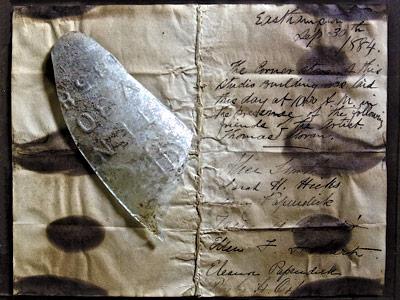Surprise Find at Moran House

Leander Arnold, a mason from Springs, found a message in a bottle while working at the Thomas Moran House restoration on Main Street in East Hampton.
More accurately, the bottle was a broken Ball canning jar, and the message was a note commemorating the laying of the cornerstone for the artist’s studio. Signed by Thomas Moran and Mary Nimmo Moran, his wife, as well as a group of friends and neighbors, the document establishes that the cornerstone was laid on Sept. 30, 1884, at 10:30 a.m.
The note was discovered in a brick support pier beneath the turret on the left side of the house. Before the restoration began there was some debate about whether to put the house back on piers once it was raised and leveled, or to put n a full basement. The decision was made to restore it as it was originally constructed. Mr. Arnold was hired by the Thomas Moran Trust to take the piers apart and clean the original bricks so they could be used as veneer on the new concrete piers.
The original piers were solid brick, but Mr. Arnold discovered that one of them was hollow. He reached inside and withdrew a glass disc. Next he removed a piece of crumbly metal, which he realized was the top of an old Ball jar. Reaching in again, he found shards of glass and a folded piece of paper. “It was like finding an old treasure map,” said Richard Barons, executive director of the trust.
The house was built by accretion, with bits and pieces added on over the years. “It was an artistic, elastic approach to the creation of a building,” said Mr. Barons. “The first engineer who took a look at the building said it was astonishing that it was still here. However, the great thing about having a house in such bad condition is that you can really open up the walls and structure and get a complete understanding of how it was built.”
Moran, who is most famous for his landscape paintings of the American West, was a scavenger who brought to East Hampton architectural components he obtained from buildings being torn down in New York City. The large bay window in the studio came from such a building, as did the stair railings and newel posts. A plinth supporting one of the bay window’s pilasters was made of cigar boxes.
Much of what has been accomplished is not visible from Main Street. Mr. Barons explained that all-new piers and a new foundation for them have been created. New sills are being installed – 80 percent of the original sills were rotten — and steel I-beams are in place.
“The desire is to get everything firmed up before winter,” Mr. Barons said, laughing as he looked out his office window at last Friday’s snowstorm. “If we had had a heavy snow a year ago, the building might have collapsed. But now the foundation is solid and the house is relatively level.”
Mr. Barons expects the exterior to be finished by year’s end and the interior restoration completed by the end of 2015. After that, it will take six months to restore the gardens. Once all restoration work is completed, the focus of the trust will turn to the educational function the building will serve. “There will be many opportunities to talk about the early days of the summer colony and about Thomas Moran himself,” Mr. Barons said. “He spent eight months a year in East Hampton, was an early member of the Maidstone Club, and was a fund-raiser for many local organizations. The Morans were very much a part of the year-round community.”
The Moran studio, which took up almost the entire ground floor of the house, was the first artist’s studio built in East Hampton. The house was declared a National Historic Landmark in 1965. More information about the restoration project, including a link to photographs of its progress, can be found at thomasmorantrust.org.
